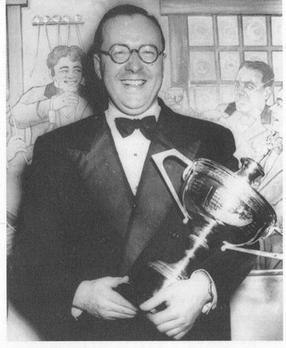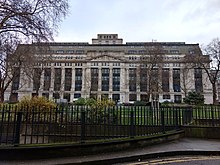
The World Snooker Championship is the longest-running and most prestigious tournament in professional snooker. It is also the richest, with total prize money in 2022 of £2,395,000, including £500,000 for the winner. First held in 1927, it is now one of the three tournaments that make up snooker's Triple Crown Series. The reigning world champion is Luca Brecel.

Raymond Reardon is a Welsh retired professional snooker player. He turned professional in 1967 aged 35 and dominated the sport in the 1970s, winning the World Snooker Championship six times and more than a dozen other tournaments. Reardon was World Champion in 1970, 1973, 1974, 1975, 1976 and 1978, and runner-up in 1982. He won the inaugural Pot Black tournament in 1969, the 1976 Masters and the 1982 Professional Players Tournament.

John Spencer was an English professional snooker player who won the World Snooker Championship title at his first attempt in 1969. He won the Championship title for the second time in 1971, and was the first player to win the championship at the Crucible Theatre when it moved there in 1977. Spencer was the inaugural winner of both the Masters and the Irish Masters tournaments, and was the first player to make a maximum break of 147 in competition, although this is not recognised as an official maximum because no check was carried out to establish whether the pockets on the table met the required specifications.

Herbert John Pulman was an English professional snooker player who was the World Snooker Champion from 1957 to 1968. He won the title at the 1957 Championship, and retained it across seven challenges from 1964 to 1968, three of them against Fred Davis and two against Rex Williams. When the tournament reverted to a knockout event in 1969 he lost 18–25 in the first round to the eventual champion John Spencer, and he was runner-up to Ray Reardon in 1970. He never reached the final again, although he was a losing semi-finalist in 1977.
Desmond Rex Williams is a retired English professional snooker and billiards player. He was the second player to make an official maximum break, achieving this in an exhibition match in December 1965. Williams won the World Professional Billiards Championship from Clark McConachy in 1968, the first time that the title had been contested since 1951. Williams retained the title in several challenge matches in the 1970s, and, after losing it to Fred Davis in 1980, regained it from 1982 to 1983.
The 1980 World Snooker Championship, officially known as the 1980 Embassy World Snooker Championship for sponsorship reasons, was a ranking professional snooker tournament that took place from 22 April to 5 May 1980 at the Crucible Theatre in Sheffield, England. The tournament was the 1980 edition of the World Snooker Championship, and was the fourth consecutive world championship to take place at the Crucible Theatre since 1977. It was sanctioned by the World Professional Billiards and Snooker Association. The total prize fund for the tournament was £60,000, of which £15,000 went to the winner.
The 1978 World Snooker Championship was a professional ranking snooker tournament that took place between 17 and 29 April 1978 at the Crucible Theatre in Sheffield, England. A qualifying competition was held at Romiley Forum, Stockport, from 27 March to 7 April. The tournament was promoted by Mike Watterson on behalf of the World Professional Billiards and Snooker Association. It had a total prize fund of £24,000, of which £7,500 went to the champion.
The 1977 World Snooker Championship was a professional snooker tournament that took place from 18 to 30 April 1977 at the Crucible Theatre in Sheffield. John Spencer won his third World Snooker Championship title by defeating Cliff Thorburn by 25 frames to 21 in the final. It was the first time that the championship was held at the Crucible, which has remained as the venue for the Championship since then. The tournament was sponsored by cigarette manufacturer Embassy.
The 1976 World Snooker Championship was a professional ranking snooker tournament that took place at two venues, Middlesbrough Town Hall, and Wythenshawe Forum, Manchester, from 7 to 23 April 1976. Qualifying matches were played at the Prince of Wales Hotel, Southport, and at the Park House Hotel, Blackpool from 29 March to 2 April. The tournament was promoted by Maurice Hayes's company Q Promotions on behalf of the World Professional Billiards and Snooker Association. The winner received £6,000 from a total prize fund of £15,300.
The 1975 World Snooker Championship was a professional snooker tournament that took place between 9 April and 1 May 1975 at various venues in Australia. The event was the 1975 edition of the World Snooker Championship, first held in 1927. The tournament featured 27 participants, eight of whom were seeded and received byes to the second round. The event featured a prize fund of A$30,000 with the winner receiving A$7,500. This was the second World Snooker Championship to be held outside of the United Kingdom after 1969, when the World Championship reverted to a knockout format. The tournament was promoted by Eddie Charlton Promotions on behalf of the World Professional Billiards and Snooker Association.
The 1974 World Snooker Championship was a professional snooker tournament that took place from 16 to 25 April 1974 at the Belle Vue in Manchester, England. It was the 1973 edition of the World Snooker Championship, established in 1927. The 1974 tournament was promoted by Snooker Promotions, and sponsored by tobacco brand Park Drive. The event attracted 31 entrants and carried a prize fund of £10,000. Seven qualifying matches were held; the seven winners of these joined the other 17 players in the main tournament.
The 1973 World Snooker Championship was a snooker tournament that took place from 16 to 28 April 1973 at the City Exhibition Halls in Manchester, England. The scheduling was a change of practice from championships in the preceding years, which had taken place over several months. The tournament was the 1973 edition of the World Snooker Championship established in 1927. The 1973 tournament was promoted by Peter West and Patrick Nally, and sponsored by tobacco brand Park Drive, with £8,000 prize money. There were 24 entrants, a new championship record.
The 1972 World Snooker Championship was a professional snooker tournament that took place between March 1971 and 26 February 1972, as an edition of the World Snooker Championship. The final was played at Selly Park British Legion from 21 to 26 February. Alex Higgins won his first world title, defeating defending champion John Spencer 37–31 in the final. Higgins also made the highest known break of the tournament, 133. In all, he won six matches to secure the title, including a 31–30 deciding frame victory over Rex Williams in the semi-final after Williams had missed an attempt to pot a blue ball. Higgins became the first qualifier to win the World Championship, and, aged 22, the youngest champion until Stephen Hendry in 1990. Higgins's win led to increased interest in snooker from the media and sponsors.
The 1969 World Snooker Championship was a professional snooker tournament. It was the first World Snooker Championship in a knock-out format since 1957, following a series of challenge matches from 1964 to 1968. John Spencer won the title, defeating Gary Owen by achieving a winning margin at 37 frames to 24 in the final. Spencer had earlier eliminated defending champion John Pulman from the competition, in the quarter-finals.
The 1971 World Snooker Championship was a professional snooker tournament that took place between 28 September and 7 November 1970 in Australia. The tournament was the 1971 edition of the World Snooker Championship, first held in 1927 but was held in 1970. It was the first time the event had been held outside England outside of two challenge matches in 1965, with matches held at various locations in New South Wales and Brisbane. The event featured nine participants, with a round-robin round producing four qualifiers, who then competed in a single-elimination tournament.

John Joseph "Jackie" Rea was a Northern Irish snooker player. He was the leading Irish snooker player until the emergence of Alex Higgins.

Fred Davis was an English professional player of snooker and English billiards. He was an eight-time World Snooker Championship winner from 1948 to 1956, and a two-time winner of the World Billiards Championship. He was the brother of 15-time world snooker champion Joe Davis; the pair were the only two players to win both snooker and English billiards world championships, and Fred is second on the list of those holding most world snooker championship titles, behind Joe.
The 1976 World Professional Match-play Championship was a professional invitational snooker tournament held from 28 November to 11 December 1976 at the Nunawading Basketball Centre in Burwood East, Melbourne, Australia. Eddie Charlton, the event's promoter, won the title by defeating Ray Reardon by 31 frames to 24 in the final. The Championship was sanctioned by the World Professional Billiards and Snooker Association, with the event's title causing confusion with the World Snooker Championship in some media reports. The tournament was not repeated.
The World Professional Match-play Championship was a professional snooker tournament established in 1952 as an alternative to the professional World Snooker Championship by some of the professional players, following a dispute with the Billiards Association and Control Council, the sport's governing body. Fred Davis won the first five editions of the tournament, but didn't participate in 1957, when John Pulman won. After this, the event was discontinued due to a decline in the popularity of snooker.







